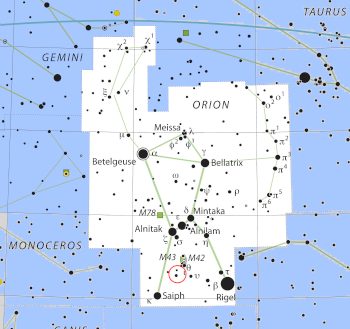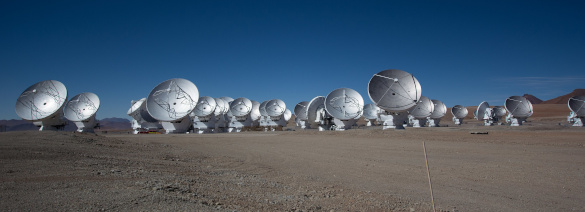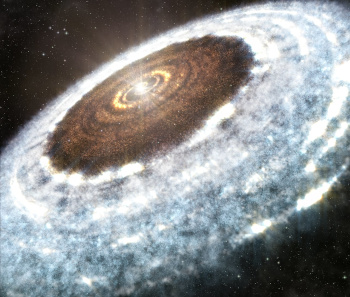Cosmic Water
May 1, 2023
Water is sometimes called the
universal solvent, since so many
substances can be
dissolved in it. That's because the water
molecule can both donate or accept a
proton and thereby act as either an
acid (proton donor) or
base (proton acceptor). This
property is called
amphoterism, and it's described by the
classic Brønsted–Lowry acid–base theory that has its hundredth
anniversary this year. This
theory was independently developed in 1923 by
Danish physical chemist,
Johannes Nicolaus Brønsted (1879-1947), and
English physical chemist,
Thomas Lowry (1874-1936).
Water is a good solvent for
ionic materials, but its action is definitely not universal, as attempts to remove
pizza sauce from
polyester fabric with plain water will attest. One
joke from my
childhood told of the
inventor of a true universal solvent and the reason he wasn't able to
sell it as a
product - No
container could hold it. Of course, today's
chemists would simply sell it as a two-part
compound, just like
epoxy glue. The
idea of a universal solvent goes back to the
16th century, and it was a
popular topic in the
17th and
18th centuries as
alchemy flourished. The fundamental problem of its containment was also understood at that time.

Alchymya, an allegorical representation of alchemy.
While modern chemists evolved from alchemists, physicists were always physicists. There's a continuum of physicists from Thales of Miletus (c.624/623-c.548/545 BC), through Galileo Galilei (1564-1642) and Isaac Newton (1642-1727), to the present day.
(Portion of a Wikimedia Commons image, Photo no. L0011583 of Wellcome Images, a website operated by the Wellcome Trust. Click for larger image.)
The universal solvent of alchemy was called
Alkahest. It was expected to dissolve all substances, including
gold, without alteration of their
components. Alkahest was called "immortal," since it would not be altered by any solute, as acids are are modified by
reaction with what they dissolve. Interestingly, one
motivation for the discovery of this universal solvent was the dissolution of
kidney stones. American alchemist,
George Starkey (1628-1665), who often
wrote under the name, Philalethes, supposed that a
vessel of any
pure element would not be dissolved by a universal solvent, since the solvent's action would be to dissolve
composite materials into their
constituent elements, so it would not dissolve a pure element.
The solvent property of water was likely the most essential
process for the
genesis of life on Earth, and it's the reason why
planetary scientists and
astronomers are always searching for
extraterrestrial water.
Radio observations of the
accretion disk around the
protostar,
V883 Orionis, suggests that the water in our
solar system was present billions of years before the
Sun.[1-2]

Location of the the protostar, V883 Orionis in the constellation of Orion.
Orion is likely the most familiar constellation after the portion of Ursa Major known as the Big Dipper. Orion is home to the unusual star, Betelgeuse (α Orionis) about which I wrote in an recent article (Boisterous Betelgeuse, October 31, 2022).
(Modified Wikimedia Commons image by ESO/IAU and Sky & Telescope. Click for larger image.)
These observations are
published in a recent
paper in
Nature by a
research team with members from the
National Radio Astronomy Observatory (Charlottesville, Virginia), the
University of Michigan (Ann Arbor, Michigan),
Leiden University (Leiden, The Netherlands), the
European Southern Observatory (Garching, Germany), the
National Astronomical Observatory of Japan (Mitaka, Japan), the
National Tsing Hua University (Hsinchu, Taiwan),
Chalmers University of Technology (Onsala, Sweden),
Northwestern University (Evanston, Illinois), and the
Universidad Diego Portales (Santiago, Chile). The observations were performed using the
Atacama Large Millimeter Array (ALMA), a
collaboration of the European Southern Observatory, the
National Science Foundation,
National Institutes of Natural Sciences (Japan), the
National Research Council (Canada), and others, in cooperation with the
Republic of Chile.[1]

The Atacama Large Millimeter Array (ALMA). (Cropped Wikimedia Commons image by Gantz.pro.)
Water is an important part of
planet formation, since it aids the growth of the solid material that eventually form
planetesimals within
stellar accretion disk.[1] As the study
authors write, the water-
snow radius and water (H
2O):
semiheavy water (HDO) ratio in
protoplanetary disks have not been well characterized.[1] This is because the water-snow radii are less than 10
astronomical units (AU), and most water is
frozen out onto
dust grains.[1] How water affects the development of
comets and planetesimals will give us an understanding of how our own Solar System developed from a giant
molecular cloud. [2] Observations of V883 Orionis with ALMA mark the first detection of water being accumulated into a protoplanetary disk without significant compositional changes.[2]
V883 Orionis is located about 1,305
light-years from
Earth, and it has a
mass of 1.3
solar masses.[1] V883 Orionis is presently in a state in which it is accreting matter, and this has increased its
luminosity to about 200 times that of the Sun.[1] The disk of V883 Orionis is massive, and previous observations suggested that its water-snow radius is in the range of 40-120 AU.[1-2] The large water region makes it a good candidate for radio observation.[2]
The research team used ALMA's highly
sensitive 1.6
millimeter and 1.3 millimeter
wavelength receivers to observe water in V883 Orionis, and they found that it was relatively unchanged between each stage of solar system formation, from
protostar, to protoplanetary disk, to comets.[2] Says
Merel van 't 'Hoff, an astronomer at the University of Michigan and a co-author of the Nature paper, "This means that the water in our Solar System was formed long before the Sun, planets, and comets formed. We already knew that there is plenty of water ice in the
interstellar medium. Our results show that this water got directly incorporated into the Solar System during its formation."[2]
The snow-water radius was found to be approximately 80 AU, a radius comparable to that of our solar system's
Kuiper Belt, and water was detected out to a radius of about 160 AU.[1] The HDO:H
2O ratio of the V883 Orionis accretion disk was found to be (2.26 ± 0.63) x 10
-3, which is comparable to that of protostellar envelopes and comets, and it exceeds that of Earth's
oceans by 3.1σ.[1] The research team concludes that accretion disks directly incorporate water from the star-forming cloud and this water is likewise incorporated into large icy bodies, such as comets, without substantial chemical alteration.[1]

An artist's impression of the water-snow line around the protostar, V883 Orionis.
(Wikimedia Commons image by A. Angelich (NRAO/AUI/NSF)/ALMA (ESO/NAOJ/NRAO) via the European Southern Observatory. Click for larger image.)
Says
John Tobin, an astronomer at the National Science Foundation's National Radio Astronomy Observatory and the
lead author of the Nature paper,
"We can think of the path of water through the Universe as a trail. We know what the endpoints look like, which are water on planets and in comets, but we wanted to trace that trail back to the origins of water... Before now, we could link the Earth to comets, and protostars to the interstellar medium, but we couldn't link protostars to comets. V883 Ori has changed that, and proven the water molecules in that system and in our Solar System have a similar ratio of deuterium and hydrogen."[2]
The
acknowledgments section of the paper was interesting, since it mentioned quite a number of
Python software packages used in the study. These were
APLpy, an
open source plotting package,
Astropy, a
community-
developed Python package for astronomy, the Python package
spectral-cube, and
matplotlib color maps from
cmocean.[1]
References:
- John J. Tobin, Merel L. R. van 't Hoff, Margot Leemker, Ewine F. van Dishoeck, Teresa Paneque-Carreño, Kenji Furuya, Daniel Harsono, Magnus V. Persson, L. Ilsedore Cleeves, Patrick D. Sheehan, and Lucas Cieza, "Deuterium-enriched water ties planet-forming disks to comets and protostars," Nature, vol. 615 (March 8, 2023), pp. 227-230, https://doi.org/10.1038/s41586-022-05676-z.
- ALMA traces history of water in planet formation back to the interstellar medium, National Radio Astronomy Observatory Press Release, March 8,2023.
Linked Keywords: Water; universal; solvent; chemical substance; solvation; dissolve; molecule; proton; acid; base (chemistry); chemical property; amphoterism; classic; Brønsted–Lowry acid–base theory; anniversary; theory; Denmark; Danish; physical chemistry; physical chemist; Johannes Nicolaus Brønsted (1879-1947); England; English; Thomas Lowry (1874-1936); ionic compound; ionic material; pizza; sauce; polyester; textile; fabric; joke; childhood; invention; inventor; sales; sell; product (business); container; chemist; chemical compound; epoxy; adhesive; glue; idea; 16th century; popularity; popular; 17th century; 18th century; alchemy; Alchymya; allegory; allegorical representation; modern history; evolution; evolve; alchemists; physicist; continuum; Thales of Miletus (c.624/623-c.548/545 BC); Galileo Galilei (1564-1642); Isaac Newton (1642-1727); Wellcome Image; Wellcome Trust; Alkahest; gold; chemical composition; component; chemical reaction; motivation; kidney stone; George Starkey (1628-1665); pseudonym; vessel (container); chemical element; pure element; composite material; constituent; chemical process; abiogenesis; genesis of life on Earth; planetary science; planetary scientist; astronomer; extraterrestrial; radio astronomy; radio observation; accretion disk; protostar; V883 Orionis; solar system; Sun; Location of the the protostar, V883 Orionis in the constellation of Orion; constellation; Orion (constellation); Ursa Major; Big Dipper; star; Betelgeuse (α Orionis); scientific literature; publish; paper; Nature (journal); research; National Radio Astronomy Observatory (Charlottesville, Virginia); University of Michigan (Ann Arbor, Michigan); Leiden University (Leiden, The Netherlands); European Southern Observatory (Garching, Germany); National Astronomical Observatory of Japan (Mitaka, Japan); National Tsing Hua University (Hsinchu, Taiwan); Chalmers University of Technology (Onsala, Sweden); Northwestern University (Evanston, Illinois); Diego Portales University; Universidad Diego Portales (Santiago, Chile); Atacama Large Millimeter Array (ALMA); collaboration; National Science Foundation; National Institutes of Natural Sciences (Japan); National Research Council (Canada); Republic of Chile; Wikimedia Commons; planet; planetesimal; stellar; accretion disk; author; snow; radius; semiheavy water (HDO); ratio; protoplanetary disk; astronomical unit (AU); freezing; frozen; cosmic dust; dust grain; comet; molecule; molecular; cloud; light-year; Earth; mass; solar masses; luminosity; sensitivity (electronics); sensitive; millimeter; wavelength; receiver (radio); Merel van 't 'Hoff; interstellar medium; Kuiper Belt; ocean; artist's impression; John Tobin; lead author; Universe; trail; endpoint; acknowledgment (creative arts and sciences); Python (programming language); computer software; software package; APLpy; free and open-source software; plot (graphics); plotting; Astropy; community; software development; spectral-cube; matplotlib; false color; color map; cmocean.